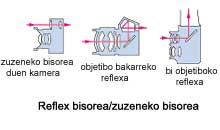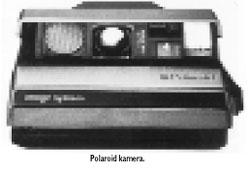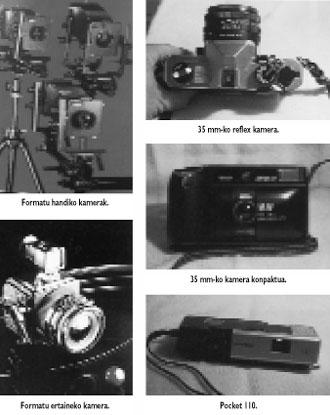Camera (II)
Elhuyar Fundazioa
Large or medium format cameras are high volume and employ 9x12, 6x9, 6x7, 6x6 (most common) and 6x4 cm negatives. Its size allows obtaining negatives of good quality. Most of the time you can change the camera background, even changing the unfinished movie (even to place the background of the instant movie). The shutter can be both focal plane that goes in the body of the camera and of sheets placed in the lens. It is a photographic system of high quality and reliability, but very expensive and mainly used by professionals.


The most used cameras are small format. Among them we have two large groups: 35 mm. and format 126 and 110. They can be 35 mm, with direct viewfinder or with reflex viewfinder (reflex cameras or SLR with a single lens). We start with those who have direct viewfinder. These cameras are basically compact. The shutter, diaphragm and lens are usually fixed or allow very small changes. They get the name because what you see from the viewfinder is not what the target sees, that is, the light goes directly to the viewfinder.
This generates a problem at short distances; problem of “parallax error” (V. the image below). These are simple and used cameras, but with their limitations: in those of fixed focus, it focuses between 2 m and infinity, requires a lot of clarity to take pictures and have the problem of framing mentioned above.
In reflex cameras, on the contrary, the light does not go directly to the viewfinder. In them the light penetrates through the lens and through a mirror and a pentaprism the image reaches the viewfinder. Therefore, what you see with your eyes in the viewer is the same image that comes to the movie. They are variable lens cameras. In addition to the objectives, there are many devices that make up the equipment of this type of cameras. It also seems that the main optical advances are applied first to these cameras.
Of those less than 35 mm, the best known is the camera in Pocket 110 (16 mm) format. Negatives of 13x17 mm are obtained and the film, being small, is embedded in the cartridge. The camera is comfortable and accessible. It usually has a fixed target. Fixed and variable exposure (represented by climatological symbols).

The most used in special cameras are Polaroid cameras to take photos at once. Through them a positive copy is taken from the camera per minute. Lets you see the result immediately. However, copies have a size limit, as they must be according to the size of the camera. In addition, as in most cases there is no negative, you cannot manipulate the copy.
The model of this section will be a single-lens reflex camera in 35 mm format for its widths and features. However, many explanations will apply to any type of camera.
The camera is therefore the center of the photographic system formed by other instruments (objectives, flash, etc. ). Nothing is needed to start making beautiful photos. It is true, however, that as we enter this world the desire and need to expand the equipment awakens, and for this the option is, above all, the reflex camera. But it is not worth it that, until we master the camera with its “normal” objective, we can complicate it with more elements. In addition, in the wide range of possibilities that exist in the market, the mixture is very simple. As we form we will specialize and know what we want.






